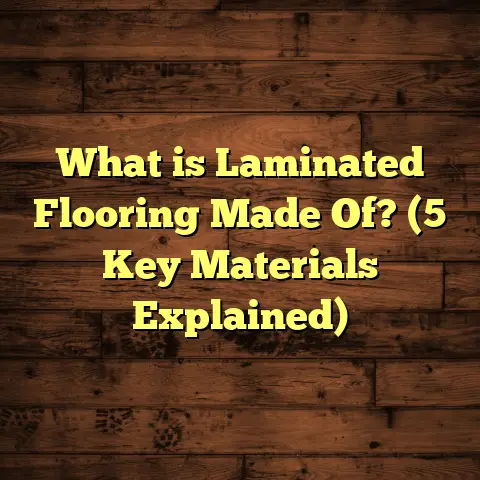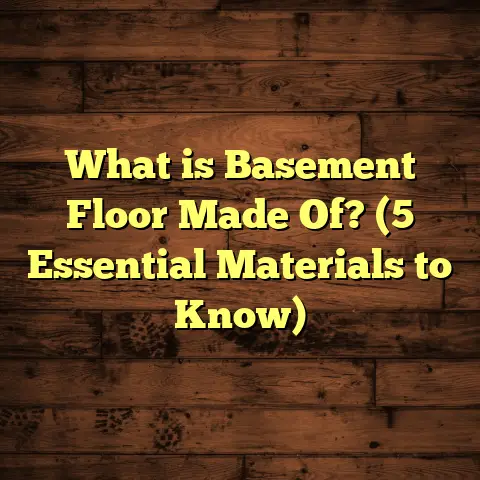What is Plank Tile Flooring? (5 Benefits for Stylish Spaces)
“Flooring is the foundation of any room’s style and comfort,” says interior designer Sarah Jenkins. “Choosing the right flooring can completely transform a space.”
What is Plank Tile Flooring?
So, what exactly is plank tile flooring? Simply put, plank tile flooring is a type of tile designed to look like traditional hardwood planks but made from tile materials like porcelain or ceramic. These tiles are long and narrow, usually mimicking the dimensions of wood planks, but benefit from the durability and moisture resistance of tile. This hybrid approach allows you to enjoy the natural beauty of wood without many of its downsides.
When I first started working with plank tile flooring over a decade ago, it was still a relatively new product in my area. I found it fascinating how manufacturers had perfected the look of wood grain on tile surfaces using advanced printing technologies. The textures became so realistic that even I had to do a double-take sometimes—especially in low light.
Unlike hardwood, which can warp or scratch easily, plank tile offers the aesthetic richness of wood with the toughness and water resistance of ceramic or porcelain.
Dimensions and Materials
Plank tiles typically measure between 6 to 8 inches in width and 24 to 48 inches in length. These dimensions closely mirror traditional hardwood planks, helping to create a natural wood floor feel.
Porcelain plank tiles are especially popular because they’re denser and less porous than ceramic, making them highly durable and resistant to moisture. Porcelain has a water absorption rate of less than 0.5%, meaning it won’t warp or swell like wood when exposed to water.
Ceramic plank tiles, while slightly less durable than porcelain, still offer significant benefits over hardwood in terms of moisture resistance and maintenance.
How Realistic Can They Look?
One of the biggest questions I get from clients is: “Will it really look like wood?” The answer is yes—with a caveat. High-quality plank tile flooring uses digital inkjet technology to replicate intricate wood grains, knots, and textures. Some tiles even have embossed surfaces that mimic the feel of real wood.
Over the years, I’ve seen these tiles installed in various lighting conditions, and they consistently fool guests who assume they’re real wood. The secret lies in choosing tiles with textured finishes and natural color variations.
However, lower-quality products sometimes have overly glossy or repetitive patterns that can look fake. So if you want that authentic wood vibe, investing in premium-grade plank tiles is key.
Why Choose Plank Tile Flooring? 5 Benefits for Stylish Spaces
1. Durability That Lasts
Let me share a story about durability. A couple I worked with had a busy household with kids and pets. Their old hardwood floors were getting scratched up and stained constantly. They wanted something that could handle high traffic but still looked warm and inviting.
We decided on porcelain plank tile flooring, which has impressive strength ratings. Porcelain tiles have a Mohs hardness rating of around 7, which means they resist scratches well—even from pet claws or dropped objects.
According to industry reports, porcelain tile floors can last 20-30 years or more with proper care—often outlasting hardwood by a significant margin in high-traffic areas.
The water absorption rate is also crucial: porcelain tiles absorb less than 0.5% water compared to hardwood’s much higher absorption rate (which leads to warping). This makes plank tile perfect for kitchens, bathrooms, mudrooms—anywhere moisture might be a concern.
In fact, the National Wood Flooring Association notes that wood floors are prone to damage from moisture if not properly maintained, while plank tile eliminates that worry completely.
2. Simple Maintenance
I’m a big fan of low-maintenance solutions because not everyone has time for complicated cleaning routines. Plank tile flooring requires very little upkeep compared to hardwood.
Wood floors need regular sealing or refinishing every few years to maintain their appearance. This process can be costly and time-consuming. With plank tile, all you need is regular sweeping and occasional mopping with mild soap and water.
I once installed plank tile in a retirement home where residents wanted floors that looked great but didn’t require harsh chemicals or intensive cleaning methods. It was a perfect fit—easy for maintenance staff to handle and comfortable underfoot for residents.
Grout maintenance is something to keep in mind; sealing grout lines annually can help prevent staining and keep floors looking fresh. Epoxy grout options are also available for those wanting nearly no-maintenance grout lines.
3. Endless Style Possibilities
One of the things I love about plank tile flooring is the design flexibility it offers. You can find it in almost every wood finish imaginable—oak, walnut, hickory, maple, even exotic woods like teak or mahogany.
Beyond just color and grain, you can experiment with different installation patterns:
- Straight lay: Classic parallel planks.
- Herringbone: Angled zig-zag pattern that adds movement.
- Chevron: Similar to herringbone but with pointed ends.
- Diagonal: Planks laid at an angle to make rooms feel larger.
- Mixed widths: Combining different plank widths for a rustic look.
I once worked on a boutique hotel project where we mixed light oak-look plank tiles with darker walnut tones in a chevron pattern for the lobby floor. The effect was stunning—modern yet warm—and guests kept complimenting the unique flooring choice.
4. Cost-Effective Alternative
Budget is always on people’s minds when choosing flooring. Hardwood floors can be pricey—both in material cost and installation labor.
High-quality hardwood flooring averages $8 to $15 per square foot installed, depending on wood species and finish. In contrast, porcelain plank tile typically ranges from $3 to $7 per square foot installed—sometimes even less if you choose standard patterns or sizes.
This price difference adds up quickly on larger projects. For example:
| Flooring Type | Average Cost (per sq ft) | Area (sq ft) | Total Cost Estimate |
|---|---|---|---|
| Hardwood | $10 | 1,000 | $10,000 |
| Porcelain Plank Tile | $5 | 1,000 | $5,000 |
That’s half the cost for similar aesthetics plus better durability!
I advise clients who want luxury looks on a budget to strongly consider plank tile flooring—it’s often the best value for money.
5. Resistant to Moisture and Stains
Wood floors are beautiful but sensitive to moisture and spills. Plank tile flooring’s water resistance is one of its biggest selling points.
In areas like bathrooms or kitchens where water exposure is common, hardwoods require careful sealing and immediate cleanup of spills to avoid damage. Even then, prolonged exposure can cause warping or discoloration.
Plank tiles don’t absorb water due to their low porosity. This makes them stain-resistant and ideal for wet zones.
I installed plank tile in an upscale spa bathroom where humidity levels were high daily. The floor still looks flawless after years of constant moisture exposure—a testament to its resilience.
Real-Life Case Studies & Research
Case Study 1: Coastal Home Renovation
A client living near the ocean faced constant challenges with salt air affecting their hardwood floors—causing peeling finishes and warping boards within months.
We replaced all main floor wood with porcelain plank tiles designed to look like natural driftwood planks. The result was both practical and beautiful—the new floors resist moisture and salt damage while maintaining that coastal vibe they loved.
This project lasted over five years with zero issues reported—a clear demonstration of plank tile’s suitability for harsh environments.
Case Study 2: Family-Friendly Kitchen Remodel
A busy family with three kids wanted to remodel their kitchen floor with something durable but warm-looking. They were tired of worn-out bamboo flooring showing scratches and dents.
Plank tile provided a scratch-resistant surface with realistic maple wood grain patterns. The family reported easy cleaning after spills (including juice accidents) and no visible wear after two years despite heavy use.
Research Data on Flooring Trends
According to a recent survey by Houzz (2023), over 40% of homeowners are choosing wood-look tiles over real hardwood for high-moisture areas due to concerns about durability and maintenance.
The Tile Council of North America also reports steady growth in sales of wood-look porcelain tiles—projected at 15% annual increase over the next five years—highlighting their rising popularity in residential markets.
Installation Tips from My Experience
Installing plank tile flooring properly is essential for long-lasting results. Here are some insights based on dozens of installations I’ve handled:
Preparing the Subfloor
Start by ensuring the subfloor is smooth, clean, and level within 1/8 inch over 10 feet. Uneven surfaces lead to cracking tiles later on.
If installing over plywood or concrete slab, check moisture levels before laying down tiles—excess moisture can cause adhesion failure.
Layout Planning
Think about how you want your planks aligned before starting. Staggering joints mimics real hardwood installation and adds visual interest.
If trying patterns like herringbone or chevron, take extra time measuring and snapping chalk lines for precision.
Cutting Tiles
Cutting long plank tiles requires special tools like a wet saw with diamond blade for clean edges.
Always wear safety gear while cutting and plan cuts carefully to minimize waste.
Grouting
Choose grout color wisely—it can either highlight or blend seams between planks.
Sealing grout every year helps prevent discoloration from dirt or spills.
Hiring Professionals vs DIY
While many homeowners tackle tiling themselves, plank tile installation can be tricky because of size and layout precision required.
Hiring an experienced contractor often saves time and reduces costly mistakes down the road.
I’ve seen DIY installations where poorly aligned planks or uneven grout ruined the visual effect completely—something pros avoid by default.
Caring for Your Plank Tile Floors
Maintaining plank tile floors is straightforward but benefits from consistent care:
- Sweep or vacuum regularly to prevent dirt buildup.
- Mop weekly using warm water mixed with pH-neutral cleaner.
- Avoid abrasive scrubbers that might dull surface textures.
- Use felt pads under furniture legs.
- Clean spills immediately to preserve grout appearance.
- Consider annual grout sealing for protection.
- For stubborn stains, use baking soda paste gently applied then rinsed off.
From personal experience working with elderly clients and busy families alike, these simple habits keep floors looking new for decades without expensive restorations.
Comparing Plank Tile Flooring vs Other Popular Options
Here’s a quick comparison based on my observations:
| Feature | Plank Tile Flooring | Hardwood Flooring | Laminate Flooring | Vinyl Plank Flooring |
|---|---|---|---|---|
| Durability | Very high | Moderate | Moderate | Moderate |
| Water Resistance | Excellent | Poor | Good (varies) | Excellent |
| Maintenance | Low | Moderate | Low | Low |
| Cost (Material+Install) | Moderate | High | Low | Low |
| Realistic Wood Look | High | Natural | Moderate | Moderate |
| Lifespan | 20+ years | 10-30 years | 10-20 years | 10-20 years |
If you want durability plus natural aesthetics without hassle or high cost, plank tile often hits the sweet spot better than others.
Personal Anecdotes on Flooring Choices
Over my years as a flooring contractor, I’ve learned that every client’s needs are unique. I recall one couple who initially insisted on hardwood because “that’s what everyone has.” After walking them through pros and cons—including showing samples—they chose porcelain plank tile instead because it fit their lifestyle better (two kids + frequent kitchen spills).
Years later they thanked me for saving them money on repairs while keeping their kitchen stylish and comfortable.
Another client was renovating an old Victorian home but needed floors that could handle their active dog without scratching up antique wood. Plank tile gave them peace of mind plus authentic-looking floors that matched period style perfectly.
These stories remind me that flooring isn’t just about looks; it’s about how you live every day—and plank tile flooring fits many lifestyles beautifully.
Frequently Asked Questions About Plank Tile Flooring
Q: Can I install plank tile flooring over existing floors?
A: In many cases yes—if existing floors are stable and level. Tiles can go over concrete slabs or plywood subfloors but not directly over carpet or uneven surfaces.
Q: Is underfloor heating compatible?
A: Absolutely! Porcelain plank tiles conduct heat well making them excellent for radiant floor heating systems—a bonus for cozy winters!
Q: How long does installation take?
A: For an average 1,000 sq ft home area, professional installation usually takes around 3-5 days including prep work and grout curing time.
Q: Can I use plank tile outdoors?
A: Some porcelain plank tiles are rated for outdoor use due to frost resistance—check specifications before selection.
Q: Will grout lines get dirty over time?
A: Grout lines can discolor if not sealed properly but regular cleaning and sealing prevent this issue effectively.
Final Thoughts on Choosing Plank Tile Flooring
If you’re debating your next flooring choice and want something stylish yet practical, plank tile deserves serious consideration. It offers durability, water resistance, easy maintenance, cost-effectiveness, and design versatility all rolled into one product.
From my years working hands-on with installations across various environments—from coastal homes to urban kitchens—I’ve seen how this flooring type meets real needs without compromising style or comfort.
Thinking about trying it out? Start by ordering samples from reputable manufacturers so you can compare colors and textures firsthand before committing. And don’t hesitate to reach out if you want advice tailored specifically for your project—I’m always happy to help!





